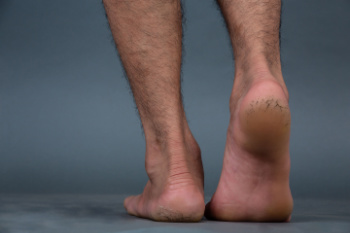
Cracked heels, also known as heel fissures, occur when the skin on the heels becomes dry and thickened, leading to painful splits. Common causes include prolonged standing or walking, especially on hard surfaces, which can put extra pressure on the heels. Dry skin, often made worse by cold weather or low humidity, contributes significantly to the condition heel fissures. Medical conditions like diabetes and eczema can also increase susceptibility. To prevent cracked heels, it is important to maintain proper foot hygiene by regularly moisturizing and exfoliating the feet to remove dead skin. Wearing well-fitting shoes that provide adequate support and cushioning can help reduce pressure on the heels. Avoiding walking barefoot on hard surfaces and keeping hydrated supports overall skin health, further reducing the risk of developing cracks. Cracked heels can be painful and can hinder completing daily activities. If you have developed this condition, it is suggested that you schedule an appointment with a chiropodist who can offer you effective treatment solutions.
Cracked heels, also known as heel fissures, can cause pain and discomfort. If your cracked heels are bothering you, please consult with one of the chiropodists from Complete Family Footcare & Therapy. Our clinicians will assess your condition and provide you with quality foot and ankle treatment.
Dry, thickened skin around the rim of the heel is typically the first sign of cracked heels. While this condition is common and usually just a nuisance, some cases can be more severe. If left untreated and as more pressure is placed on the heel, the cracks become deeper and eventually walking and standing can be painful. These deep cracks or fissures can bleed and also become infected. Those with diabetes need to be especially careful as fissures could lead to diabetic foot ulcers.
Causes
Cracked heels can be the result of several different factors, including:
Dry skin
Taking long, hot showers or using harsh soaps
Standing for long periods of time
Walking barefoot
Walking in shoes with an open back, such as sandals or flip flops
Wearing shoes that do not fit properly
Living in a cold or dry climate
Certain skin conditions, such as eczema or psoriasis
Treatment
There are many at-home treatment remedies for cracked heels. Applying moisturizers to the heel can help hydrate the skin. Soaking your feet in warm water and exfoliating them with a loofah or pumice stone can help to buff away dead skin cells. If you are afflicted with cracked heels, it is recommended that you see a chiropodist for treatment.
Prevention
You can prevent cracked heels by:
Avoiding standing in one position for prolonged periods of time
Wearing well-fitted shoes with a closed back
Washing your feet with gentle soaps and lukewarm water
Moisturizing the feet daily
If you have any questions, please feel free to contact our offices located in . We offer the newest diagnostic and treatment technologies for all your foot care needs.
